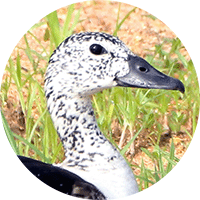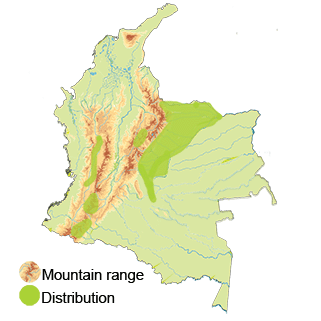American Comb Duck
Appearance: The American Comb Duck is a large waterfowl species (76 cm - 30 inches) with a unique appearance. The males has a striking combination of colors, including a black head, neck, and upper body, a white lower body, and a red bill with a large black comb-like structure on bill. Black speckling on whitish head and underparts, wings all dark. Males and females have similar plumage, although males often have more pronounced combs and larger body size.
Habitat: This species is found in tropical and subtropical wetland habitats. It inhabits marshes, swamps, flooded grasslands, and shallow lakes with abundant vegetation. American Comb Ducks are often found in areas with standing or slow-moving water that provides both nesting sites and access to their preferred diet of aquatic vegetation, seeds, and invertebrates. Perches on trees. From 500 to 3400 m also in La Guajira and Los Llanos Orientales.
Behavior: American Comb Ducks are social birds and can be observed in small groups or larger flocks. They are excellent swimmers and are capable of navigating through dense vegetation in wetland habitats. These ducks are known for their ability to perch on trees or branches, which is unusual behavior for most species in the Anatidae family.
Breeding: During the breeding season, male American Comb Ducks engage in courtship displays to attract females. These displays involve head bobbing, posturing, and vocalizations. Nesting occurs within the dense vegetation near water bodies. The female constructs a well-hidden nest constructed with plant material, where she lays a clutch of several eggs. Both parents participate in rearing the ducklings once they hatch.
Conservation Status: In terms of its international conservation status, the American Comb Duck is listed as Least Concern by the International Union for Conservation of Nature (IUCN).
Distribution
The American Comb Duck (Sarkidiornis sylvicola) is primarily found in the northern and central regions of South America. Its range includes countries such as Venezuela, Guyana, Suriname, French Guiana, Brazil, Ecuador, Peru, Bolivia, and northern Argentina, in Colombia its rarely found.
Taxonomy
- Kingdom: Animalia
- Phylum: Chordata
- Class: Aves (Birds)
- Order: Anseriformes (Waterfowl)
- Family: Anatidae (Ducks, Geese, Swans)
- Genus: Sarkidiornis
- Species: Sarkidiornis sylvicola
Vocalization
The typical call of the American Comb Duck is a distinctive "gobbled" or "growling" sound, often described as a low-pitched rolling "ga-roo-roo". These calls can be quite deep and resonant, carrying over long distances. These vocalizations are used for a variety of purposes. Males often produce calling displays to attract females or defend their territories, while females may emit calls to communicate with their ducklings or other members of their group.
Additionally, the American Comb Duck may produce soft grunts or whistles during courtship or social interactions. Compared to other ducks, it is generally less vocal overall.
It is worth noting that variations in vocalizations may exist among populations or individuals, and further research on vocalizations of this species is continually being conducted to better understand their communication behaviors.
While the American Comb Duck may not have an extensive vocal repertoire, its distinct "gobbled" call adds to the uniqueness of this species.





